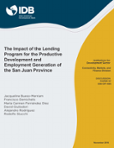The Impact of the Lending Program for the Productive Development and Employment Generation of the San Juan Province
Date
Nov 2016
A shortcoming of the current empirical impact evaluation literature is the lack of studies that measure the effect of access to credit in the medium and long term, as well as the impact on interventions targeted at micro-, small-, and medium-sized enterprises (MSMEs). This study addresses both aspects by analyzing the average impact that the Lending Program for the Productive Development and Employment Generation of the San Juan Province has had on sales, employment, investment, and productivity of beneficiary MSMEs. The authors measured the abovementioned impacts using a lagged dependent variable (LDV) model that, beyond controlling for selection bias, also controls for the sequential entry of companies into the program. To conduct this analysis, the authors used a survey implemented by the National University of San Juan to 664 companies. The results of the study indicate a positive and statistically significant impact of 6.9 percent on the likelihood to invest, 9.7 percent on sales, 4.3 percent on employment, and 6.4 percent on labor productivity. The analysis allows for the identification of differentiated impacts by type of company, as classified by size and sector or type of economic activity.



